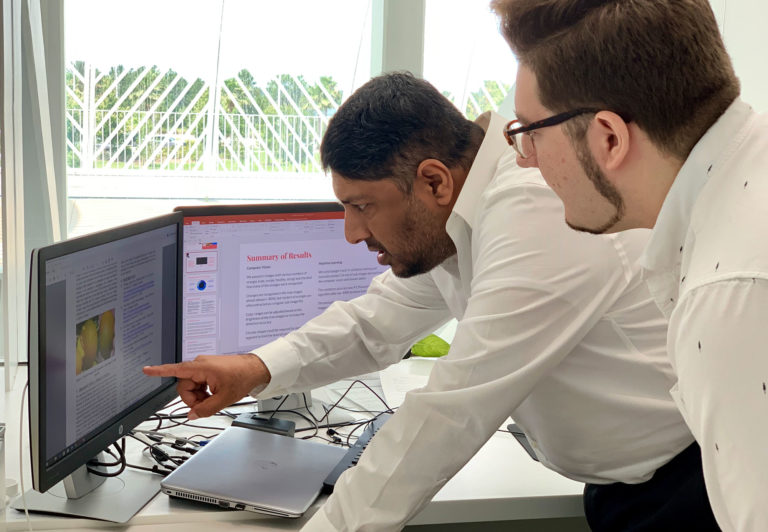Florida Poly Research Sets Sights on Citrus Greening
by MATT COBBLE
photo courtesy of Florida Polytechnic University
Florida Citrus growers will soon have another weapon in their arsenal for the fight against citrus greening, thanks to the research of a team from Florida Polytechnic University. Dr. Muhammad Abid, assistant computer science professor at Florida Poly, has been leading the development of a computer algorithm that compares live images captured in a grove to a database of images of both healthy and infected trees. Using the results of these image comparisons, the algorithm can accurately predict if the trees screened are infected with greening or are healthy.
The project originated at the request of a client – could Dr. Abid and his students develop a means of recognizing the visual signs of greening infection in plants as reliably as a food or disease inspector? Although his first foray into the agricultural world, this particular course of research seemed like a perfect fit for Dr. Abid, whose specialties include computer imagery and pattern recognition, to tackle. Thus began the Citrus Greening Infection Detection (CiGID) algorithm.
The behavior of the CiGID algorithm is the result of supervised learning, a process in which a computer program generates a result by mapping data input into the system to a desired output by comparing this newest input to a set of pre-set input-output pairs (referred to as ‘training data.’) In this case, the algorithm is comparing the sizes of fruit on the tree, the shape of that fruit, and the color of the fruit to a database of images, showing healthy and infected fruits alike.
Current methods of checking a grove for greening involve a trained inspector, who would then inspect the fruit of the trees to determine which were showing signs of infection, and which were not. These inspections would take time, both in waiting for the inspector to be available, and for the inspector to walk the grove, looking at the fruit of each individual tree. Dr. Abid hopes that, when the CiGID algorithm is deployed, the time element can be nearly eliminated. “The app processes the images in real time – detecting the tree, finding the fruit, and comparing the fruit to the database of images of heathy and infected fruit.”
What makes Dr. Abid’s algorithm unique is the focus on making the technology available to all growers. “Some solutions rely on costly hardware or software,” Abid says. “The price can be too high for smaller operations.” Instead, Abid and his team looked to create a tool that could be installed on any dedicated device. In addition, rather than relying on higher end, more expensive cameras, the CiGID algorithm was designed to work with any digital camera the grower has available – a simple twenty-dollar webcam is sufficient in most cases.
Ideally, the algorithm will either be paired with, or installed onto, a drone with a camera. In this arrangement, a geofence would keep the drone within the bounds of the grove, while the CiGID and camera work collaboratively to identify each tree, scan the fruit, and tabulate which trees show signs of infection, versus those trees which appear healthy. “The app has all the knowledge of the inspector,” Abid said. “But the processing is much faster. This process would save growers time, is easier to implement, and is cheaper.
First seen in Florida groves back in 2005, citrus greening, also known as Huanglongbing (HLB) or yellow dragon disease, is a bacterial infection, typically transmitted by the Asian citrus psyllid. Unfortunately, there is still no known cure for citrus greening, but earlier detection of the disease would allow growers to take early steps to prolong the life and productivity of infected trees or establish quarantine around those trees to ensure healthy trees remain healthy. Eventually, however, infected trees must be removed from the grove before the disease can spread to the neighboring trees.
The research Dr. Abid and his team have done in this field is gaining international attention. In April, Abid and Soini presented their work at the International Conference on Information System and Data Mining, held at the University of Houston in Texas. They also plan to publish their findings in the International Conference Proceedings Series by the Association for Computer Machinery (ACM).
As for future plans for this algorithm, Dr. Abid has a track in mind. “We would like to develop our work into an app and make it available to the public.” Eventually, Dr. Abid and his team “can also begin to train the app to recognize the visible symptoms of other diseases in other plants.”
Dr. Abid has ideas for use in preventative treatment as well. “We want to determine if this type of image analysis can calculate the age and the mass of the trees, to help measure the degree of vaccination to provide to each tree.” Eventually, this could lead to a drone that scans a tree, and directly dispenses the appropriate amount of vaccination to said tree.
Dr. Abid was assisted in the development of the algorithm by two Florida Poly students, both of whom have now graduated. Sofiane Fellah, a computer engineering student, graduated in 2018, while Charles Soini, who studied computer science, graduated in 2019.

